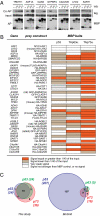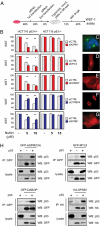A genome-scale protein interaction profile of Drosophila p53 uncovers additional nodes of the human p53 network
- PMID: 20308539
- PMCID: PMC2851947
- DOI: 10.1073/pnas.1002447107
A genome-scale protein interaction profile of Drosophila p53 uncovers additional nodes of the human p53 network
Abstract
The genome of the fruitfly Drosophila melanogaster contains a single p53-like protein, phylogenetically related to the ancestor of the mammalian p53 family of tumor suppressors. We reasoned that a comprehensive map of the protein interaction profile of Drosophila p53 (Dmp53) might help identify conserved interactions of the entire p53 family in man. Using a genome-scale in vitro expression cloning approach, we identified 91 previously unreported Dmp53 interactors, considerably expanding the current Drosophila p53 interactome. Looking for evolutionary conservation of these interactions, we tested 41 mammalian orthologs and found that 37 bound to one or more p53-family members when overexpressed in human cells. An RNAi-based functional assay for modulation of the p53 pathway returned five positive hits, validating the biological relevance of these interactions. One p53 interactor is GTPBP4, a nucleolar protein involved in 60S ribosome biogenesis. We demonstrate that GTPBP4 knockdown induces p53 accumulation and activation in the absence of nucleolar disruption. In breast tumors with wild-type p53, increased expression of GTPBP4 correlates with reduced patient survival, emphasizing a potential relevance of this regulatory axis in cancer.
Conflict of interest statement
The authors declare no conflict of interest.
Figures




Similar articles
-
Role of DREF in transcriptional regulation of the Drosophila p53 gene.Oncogene. 2010 Apr 8;29(14):2060-9. doi: 10.1038/onc.2009.483. Epub 2010 Jan 18. Oncogene. 2010. PMID: 20101238
-
Chk2 regulates irradiation-induced, p53-mediated apoptosis in Drosophila.Proc Natl Acad Sci U S A. 2002 Aug 20;99(17):11305-10. doi: 10.1073/pnas.172382899. Epub 2002 Aug 9. Proc Natl Acad Sci U S A. 2002. PMID: 12172011 Free PMC article.
-
The p53 control of apoptosis and proliferation: lessons from Drosophila.Apoptosis. 2014 Oct;19(10):1421-9. doi: 10.1007/s10495-014-1035-7. Apoptosis. 2014. PMID: 25217223 Free PMC article. Review.
-
Loss of Drosophila nucleostemin 2 (NS2) blocks nucleolar release of the 60S subunit leading to ribosome stress.Chromosoma. 2017 Jun;126(3):375-388. doi: 10.1007/s00412-016-0597-2. Epub 2016 May 6. Chromosoma. 2017. PMID: 27150106
-
Guardian ancestry: fly p53 and damage-inducible apoptosis.Cell Death Differ. 2000 Nov;7(11):1035-8. doi: 10.1038/sj.cdd.4400766. Cell Death Differ. 2000. PMID: 11139275 Review.
Cited by
-
Predicting targeted drug combinations based on Pareto optimal patterns of coexpression network connectivity.Genome Med. 2014 Apr 30;6(4):33. doi: 10.1186/gm550. eCollection 2014. Genome Med. 2014. PMID: 24944582 Free PMC article.
-
Diapause and quiescence: dormancy mechanisms that contribute to the geographical expansion of mosquitoes and their evolutionary success.Parasit Vectors. 2017 Jun 26;10(1):310. doi: 10.1186/s13071-017-2235-0. Parasit Vectors. 2017. PMID: 28651558 Free PMC article. Review.
-
Drosophila p53 directs nonapoptotic programs in postmitotic tissue.Mol Biol Cell. 2019 May 15;30(11):1339-1351. doi: 10.1091/mbc.E18-12-0791. Epub 2019 Mar 20. Mol Biol Cell. 2019. PMID: 30892991 Free PMC article.
-
Integrated bioinformatic analysis of RNA binding proteins in hepatocellular carcinoma.Aging (Albany NY). 2020 Dec 19;13(2):2480-2505. doi: 10.18632/aging.202281. Epub 2020 Dec 19. Aging (Albany NY). 2020. PMID: 33411682 Free PMC article.
-
GTPBP4 promotes hepatocellular carcinoma progression and metastasis via the PKM2 dependent glucose metabolism.Redox Biol. 2022 Oct;56:102458. doi: 10.1016/j.redox.2022.102458. Epub 2022 Sep 10. Redox Biol. 2022. PMID: 36116159 Free PMC article.
References
Publication types
MeSH terms
Substances
LinkOut - more resources
Full Text Sources
Molecular Biology Databases
Research Materials
Miscellaneous

